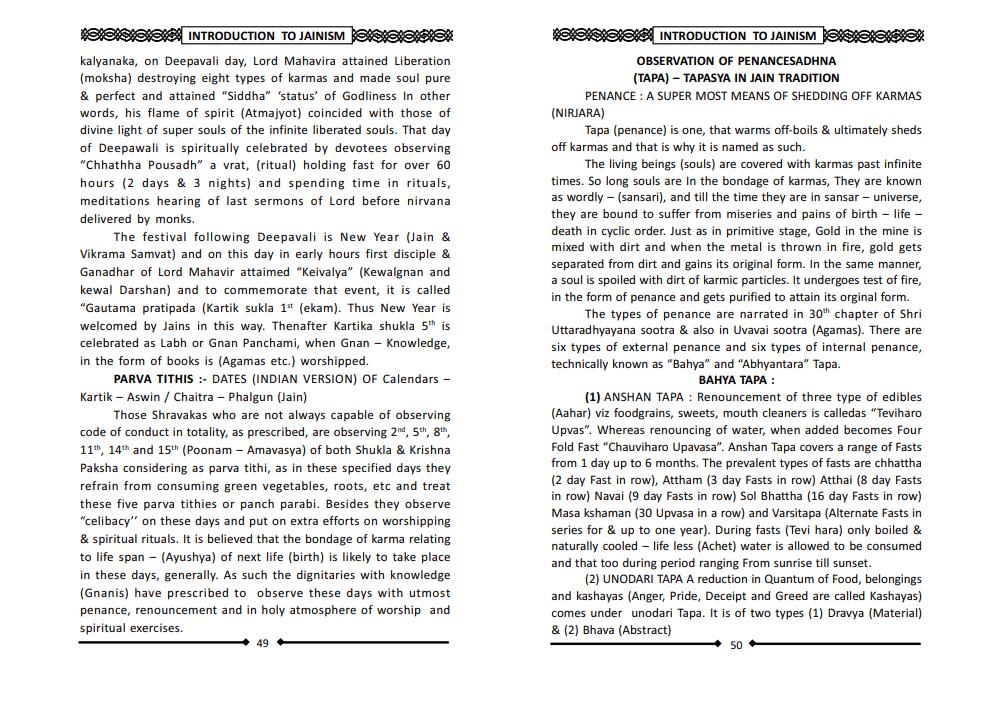________________
918131316INTRODUCTION TO JAINISMO SISSA kalyanaka, on Deepavali day, Lord Mahavira attained Liberation (moksha) destroying eight types of karmas and made soul pure & perfect and attained "Siddha" 'status' of Godliness In other words, his flame of spirit (Atmajyot) coincided with those of divine light of super souls of the infinite liberated souls. That day of Deepawali is spiritually celebrated by devotees observing "Chhathha Pousadh" a vrat, (ritual) holding fast for over 60 hours (2 days & 3 nights) and spending time in rituals, meditations hearing of last sermons of Lord before nirvana delivered by monks.
The festival following Deepavali is New Year (Jain & Vikrama Samvat) and on this day in early hours first disciple & Ganadhar of Lord Mahavir attaimed "Keivalya" (Kewalgnan and kewal Darshan) and to commemorate that event, it is called "Gautama pratipada (Kartik sukla 1" (ekam). Thus New Year is welcomed by Jains in this way. Thenafter Kartika shukla 5 is celebrated as Labh or Gnan Panchami, when Gnan - Knowledge, in the form of books is (Agamas etc.) worshipped.
PARVA TITHIS :- DATES (INDIAN VERSION) OF Calendars - Kartik - Aswin / Chaitra - Phalgun (Jain)
Those Shravakas who are not always capable of observing code of conduct in totality, as prescribed, are observing 2nd, 5th, 8th, 11", 14th and 15th (Poonam - Amavasya) of both Shukla & Krishna Paksha considering as parva tithi, as in these specified days they refrain from consuming green vegetables, roots, etc and treat these five parva tithies or panch parabi. Besides they observe "celibacy" on these days and put on extra efforts on worshipping & spiritual rituals. It is believed that the bondage of karma relating to life span -(Ayushya) of next life (birth) is likely to take place in these days, generally. As such the dignitaries with knowledge (Gnanis) have prescribed to observe these days with utmost penance, renouncement and in holy atmosphere of worship and spiritual exercises.
. ASISK, INTRODUCTION TO JAINISM A SKER
OBSERVATION OF PENANCESADHNA
(TAPA) - TAPASYA IN JAIN TRADITION PENANCE: A SUPER MOST MEANS OF SHEDDING OFF KARMAS (NIRJARA)
Tapa (penance) is one, that warms off-boils & ultimately sheds off karmas and that is why it is named as such.
The living beings (souls) are covered with karmas past infinite times. So long souls are in the bondage of karmas, They are known as wordly-(sansari), and till the time they are in sansar - universe, they are bound to suffer from miseries and pains of birth -lifedeath in cyclic order. Just as in primitive stage, Gold in the mine is mixed with dirt and when the metal is thrown in fire, gold gets separated from dirt and gains its original form. In the same manner, a soul is spoiled with dirt of karmic particles. It undergoes test of fire, in the form of penance and gets purified to attain its orginal form.
The types of penance are narrated in 30 chapter of Shri Uttaradhyayana sootra & also in Uvavai sootra (Agamas). There are six types of external penance and six types of internal penance, technically known as "Bahya" and "Abhyantara" Tapa.
BAHYA TAPA : (1) ANSHAN TAPA : Renouncement of three type of edibles (Aahar) viz foodgrains, sweets, mouth cleaners is calledas "Teviharo Upvas". Whereas renouncing of water, when added becomes Four Fold Fast "Chauviharo Upavasa". Anshan Tapa covers a range of Fasts from 1 day up to 6 months. The prevalent types of fasts are chhattha (2 day Fast in row), Attham (3 day Fasts in row) Atthai (8 day Fasts in row) Naval (9 day Fasts in row) Sol Bhattha (16 day Fasts in row) Masa kshaman (30 Upvasa in a row) and Varsitapa (Alternate Fasts in series for & up to one year). During fasts (Tevi hara) only boiled & naturally cooled-life less (Achet) water is allowed to be consumed and that too during period ranging From sunrise till sunset.
(2) UNODARI TAPA A reduction in Quantum of Food, belongings and kashayas (Anger, Pride, Deceipt and Greed are called Kashayas) comes under unodari Tapa. It is of two types (1) Dravya (Material) & (2) Bhava (Abstract)
49




